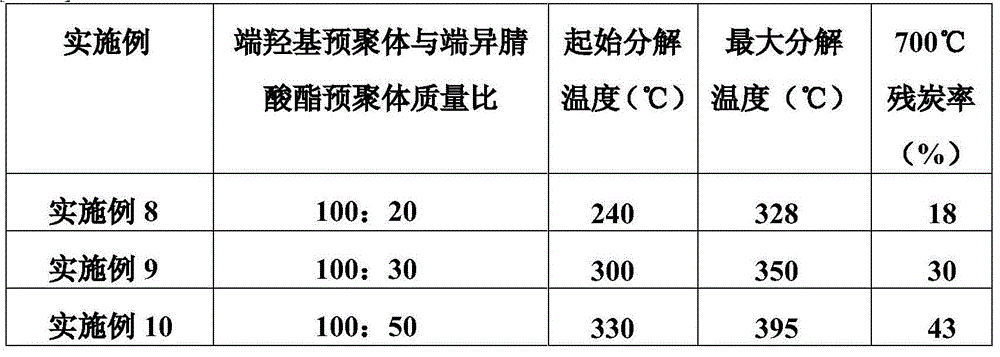Preparation method of carborane polyurethane resin
A technology of polyurethane resin and carborane, which is applied in the field of preparation of carborane polyurethane resin, can solve the problems of low softening temperature and thermal decomposition temperature, limited application range, and low retention rate of mechanical properties, and achieve good mechanical properties and thermal stability. Stability, low cost, and easy curing
- Summary
- Abstract
- Description
- Claims
- Application Information
AI Technical Summary
Problems solved by technology
Method used
Image
Examples
Embodiment 1
[0023] 60.00g polyester polyol (polybutylene adipate, between 57% of hydroxyl value, number-average molecular weight is 2000, the following examples are all this material without explanation) join in the 500ml there-necked bottle, in- 0.1MPa, under the condition of 105 ℃, carry out dehydration treatment for 1.5 hours, add 4,4-diphenylmethane diisocyanate (6.00g), carborane polyarylate (0.66g), dibutyltin dilaurate ( 0.20 g) and ethyl acetate (15 ml), stirred and reacted at 65° C. for 1 hour. After adding 135ml of acetone to reduce the viscosity and react for 2 hours, a light yellow low-viscosity hydroxyl-terminated carborane polyurethane prepolymer was obtained. Dissolve 9.28g of 4,4-diphenylmethane diisocyanate in 10ml of ethyl acetate, add it to a 250ml four-necked flask, and dissolve 1.62g of p-phenol-1,2-carborane at 65°C Add the mixed solution of 1.34g trimethylolpropane and ethyl acetate dropwise into the flask, wherein the amount of ethyl acetate is 5 times the mass of...
Embodiment 2
[0025]60.00g polyester polyol (polybutylene adipate, should the hydroxyl value be between 57% and 2000, the number average molecular weight is 2000, and the following examples are all this material if there is no description) into 500ml three ports In the bottle, dehydration treatment was carried out at -0.1MPa and 105°C for 1 hour, and 4,4-diphenylmethane diisocyanate (6.00g), carborane polyarylate (0.66g), di A mixed solution of dibutyltin laurate (0.20 g) and ethyl acetate (15 ml) was stirred and reacted at 65° C. for 1 hour. After adding 135ml of acetone to reduce the viscosity and react for 2 hours, a light yellow low-viscosity hydroxyl-terminated carborane polyurethane prepolymer was obtained. Dissolve 9.28g of 4,4-diphenylmethane diisocyanate in 10ml of ethyl acetate, add it to a 250ml four-necked flask, and dissolve 1.62g of p-phenol-1,7-carborane at 55°C Add the mixed solution of 1.34g trimethylolpropane and ethyl acetate dropwise into the flask, wherein the amount o...
Embodiment 3
[0027] 60.00g polyester polyol (polybutylene adipate, should the hydroxyl value be between 57% and 2000, the number average molecular weight is 2000, and the following examples are all this material if there is no description) into 500ml three ports In the bottle, dehydration treatment was carried out at -0.1MPa and 105°C for 2 hours, and 4,4-diphenylmethane diisocyanate (6.00g), carborane polyarylate (0.66g), di A mixed solution of dibutyltin laurate (0.20g) and ethyl acetate (15ml) was stirred and reacted at 85°C for 1 hour. After adding 135ml of acetone to reduce the viscosity and react for 2 hours, a light yellow low-viscosity hydroxyl-terminated carborane polyurethane prepolymer was obtained. Dissolve 9.28g of 4,4-diphenylmethane diisocyanate in 10ml of ethyl acetate, add it to a 250ml four-necked flask, and dissolve 1.62g of p-phenol-1,12-carborane at 65°C Add the mixed solution of 1.34g trimethylolpropane and ethyl acetate dropwise into the flask, wherein the amount of...
PUM
 Login to View More
Login to View More Abstract
Description
Claims
Application Information
 Login to View More
Login to View More - R&D
- Intellectual Property
- Life Sciences
- Materials
- Tech Scout
- Unparalleled Data Quality
- Higher Quality Content
- 60% Fewer Hallucinations
Browse by: Latest US Patents, China's latest patents, Technical Efficacy Thesaurus, Application Domain, Technology Topic, Popular Technical Reports.
© 2025 PatSnap. All rights reserved.Legal|Privacy policy|Modern Slavery Act Transparency Statement|Sitemap|About US| Contact US: help@patsnap.com



